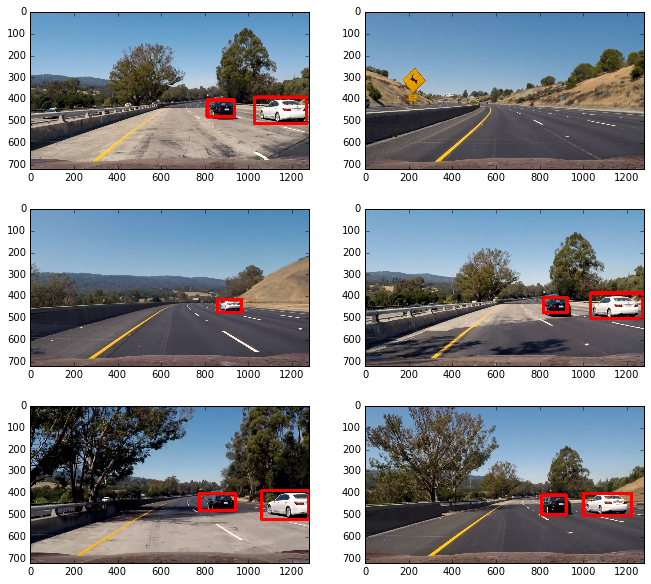xslittlegrass / Carnd Vehicle Detection
Projects that are alternatives of or similar to Carnd Vehicle Detection
Vehicle Detection Project
This is a project for Udacity self-driving car Nanodegree program. The aim of this project is to detect the vehicles in a dash camera video. The implementation of the project is in the file vehicle_detection.ipynb. This implementation is able to achieve 21FPS without batching processing. The final video output is here.
In this README, each step in the pipeline will be explained in details.
Introduction to object detection
Detecting vehicles in a video stream is an object detection problem. An object detection problem can be approached as either a classification problem or a regression problem. As a classification problem, the image are divided into small patches, each of which will be run through a classifier to determine whether there are objects in the patch. Then the bounding boxes will be assigned to locate around patches that are classified with high probability of present of an object. In the regression approach, the whole image will be run through a convolutional neural network to directly generate one or more bounding boxes for objects in the images.
| classification | regression |
|---|---|
| Classification on portions of the image to determine objects, generate bounding boxes for regions that have positive classification results. | Regression on the whole image to generate bounding boxes |
| 1. sliding window + HOG 2. sliding window + CNN 3. region proposals + CNN | generate bounding box coordinates directly from CNN |
| RCNN, Fast-RCNN, Faster-RCNN | SSD, YOLO |
In this project, we will use tiny-YOLO v1, since it's easy to implement and are reasonably fast.
The tiny-YOLO v1
Architecture of the convolutional neural network
The tiny YOLO v1 is consist of 9 convolution layers and 3 full connected layers. Each convolution layer consists of convolution, leaky relu and max pooling operations. The first 9 convolution layers can be understood as the feature extractor, whereas the last three full connected layers can be understood as the "regression head" that predicts the bounding boxes.
There are a total of 45,089,374 parameters in the model and the detail of the architecture is in list in this table
____________________________________________________________________________________________________
Layer (type) Output Shape Param # Connected to
====================================================================================================
convolution2d_1 (Convolution2D) (None, 16, 448, 448) 448 convolution2d_input_1[0][0]
____________________________________________________________________________________________________
leakyrelu_1 (LeakyReLU) (None, 16, 448, 448) 0 convolution2d_1[0][0]
____________________________________________________________________________________________________
maxpooling2d_1 (MaxPooling2D) (None, 16, 224, 224) 0 leakyrelu_1[0][0]
____________________________________________________________________________________________________
convolution2d_2 (Convolution2D) (None, 32, 224, 224) 4640 maxpooling2d_1[0][0]
____________________________________________________________________________________________________
leakyrelu_2 (LeakyReLU) (None, 32, 224, 224) 0 convolution2d_2[0][0]
____________________________________________________________________________________________________
maxpooling2d_2 (MaxPooling2D) (None, 32, 112, 112) 0 leakyrelu_2[0][0]
____________________________________________________________________________________________________
convolution2d_3 (Convolution2D) (None, 64, 112, 112) 18496 maxpooling2d_2[0][0]
____________________________________________________________________________________________________
leakyrelu_3 (LeakyReLU) (None, 64, 112, 112) 0 convolution2d_3[0][0]
____________________________________________________________________________________________________
maxpooling2d_3 (MaxPooling2D) (None, 64, 56, 56) 0 leakyrelu_3[0][0]
____________________________________________________________________________________________________
convolution2d_4 (Convolution2D) (None, 128, 56, 56) 73856 maxpooling2d_3[0][0]
____________________________________________________________________________________________________
leakyrelu_4 (LeakyReLU) (None, 128, 56, 56) 0 convolution2d_4[0][0]
____________________________________________________________________________________________________
maxpooling2d_4 (MaxPooling2D) (None, 128, 28, 28) 0 leakyrelu_4[0][0]
____________________________________________________________________________________________________
convolution2d_5 (Convolution2D) (None, 256, 28, 28) 295168 maxpooling2d_4[0][0]
____________________________________________________________________________________________________
leakyrelu_5 (LeakyReLU) (None, 256, 28, 28) 0 convolution2d_5[0][0]
____________________________________________________________________________________________________
maxpooling2d_5 (MaxPooling2D) (None, 256, 14, 14) 0 leakyrelu_5[0][0]
____________________________________________________________________________________________________
convolution2d_6 (Convolution2D) (None, 512, 14, 14) 1180160 maxpooling2d_5[0][0]
____________________________________________________________________________________________________
leakyrelu_6 (LeakyReLU) (None, 512, 14, 14) 0 convolution2d_6[0][0]
____________________________________________________________________________________________________
maxpooling2d_6 (MaxPooling2D) (None, 512, 7, 7) 0 leakyrelu_6[0][0]
____________________________________________________________________________________________________
convolution2d_7 (Convolution2D) (None, 1024, 7, 7) 4719616 maxpooling2d_6[0][0]
____________________________________________________________________________________________________
leakyrelu_7 (LeakyReLU) (None, 1024, 7, 7) 0 convolution2d_7[0][0]
____________________________________________________________________________________________________
convolution2d_8 (Convolution2D) (None, 1024, 7, 7) 9438208 leakyrelu_7[0][0]
____________________________________________________________________________________________________
leakyrelu_8 (LeakyReLU) (None, 1024, 7, 7) 0 convolution2d_8[0][0]
____________________________________________________________________________________________________
convolution2d_9 (Convolution2D) (None, 1024, 7, 7) 9438208 leakyrelu_8[0][0]
____________________________________________________________________________________________________
leakyrelu_9 (LeakyReLU) (None, 1024, 7, 7) 0 convolution2d_9[0][0]
____________________________________________________________________________________________________
flatten_1 (Flatten) (None, 50176) 0 leakyrelu_9[0][0]
____________________________________________________________________________________________________
dense_1 (Dense) (None, 256) 12845312 flatten_1[0][0]
____________________________________________________________________________________________________
dense_2 (Dense) (None, 4096) 1052672 dense_1[0][0]
____________________________________________________________________________________________________
leakyrelu_10 (LeakyReLU) (None, 4096) 0 dense_2[0][0]
____________________________________________________________________________________________________
dense_3 (Dense) (None, 1470) 6022590 leakyrelu_10[0][0]
====================================================================================================
Total params: 45,089,374
Trainable params: 45,089,374
Non-trainable params: 0
____________________________________________________________________________________________________
In this project, we will use Keras to construct the YOLO model.
Postprocessing
The output of this network is a 1470 vector, which contains the information for the predicted bounding boxes. The information is organized in the following way

The 1470 vector output is divided into three parts, giving the probability, confidence and box coordinates. Each of these three parts is also further divided into 49 small regions, corresponding to the predictions at each cell. In postprocessing steps, we take this 1470 vector output from the network to generate the boxes that with a probability higher than a certain threshold. The detail of these steps are in the yolo_net_out_to_car_boxes function in the utili class.
Use pretrained weights
Training the YOLO network is time consuming. We will download the pretrained weights from here (172M) and load them into our Keras model. The weight loading function is in the load_weight function in the utili class
load_weights(model,'./yolo-tiny.weights')
Note that tensorflow is used for the backend in this project.
Results
The following shows the results for several test images with a threshold of 0.17. We can see that the cars are detected:
Here is the result of applying the same pipeline to a video.
Discussion
The YOLO is known to be fast. In the original paper, the tiny-YOLO is reported to work at nearly 200 FPS on a powerful desktop GPU. In this project, the video is processed on a Nvidia 1070 and the rate is about 21FS without batch processing.
Reference
- J. Redmon, S. Divvala, R. Girshick, and A. Farhadi, You Only Look Once: Unified, Real-Time Object Detection, arXiv:1506.02640 (2015).
- J. Redmon and A. Farhadi, YOLO9000: Better, Faster, Stronger, arXiv:1612.08242 (2016).
- darkflow, https://github.com/thtrieu/darkflow
- Darknet.keras, https://github.com/sunshineatnoon/Darknet.keras/
- YAD2K, https://github.com/allanzelener/YAD2K


